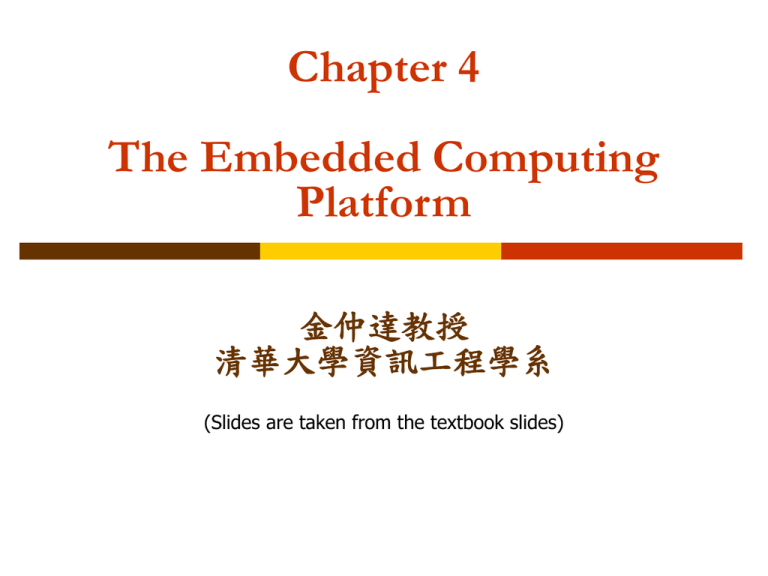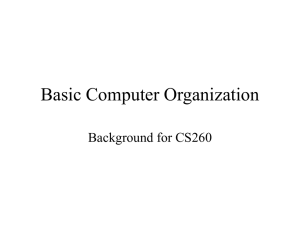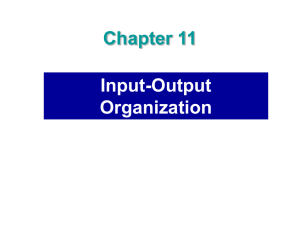CPU bus - 國立清華大學資訊工程系
advertisement

Chapter 4
The Embedded Computing
Platform
金仲達教授
清華大學資訊工程學系
(Slides are taken from the textbook slides)
Outline
CPU Bus and DMA
Memory and I/O Devices
Component Interfacing
Designing with Microprocessors
Development, Debugging, Testing
Design Example: Alarm Clock
Computing Platform-1
CPU bus
Connects CPU to memory and device
Bus protocol controls communication between
entities
decides who gets to use bus at any particular time
governs length, style of communication
Four-cycle handshake:
Basis of many bus protocols
2 wires: enq (enquiry) and ack (acknowledgment)
enq
dev1
data
dev2
ack
Computing Platform-2
Four-cycle example
enq
1
3
2
data
4
ack
time
Computing Platform-3
Typical bus signals
Clock
R/W’: true when bus is reading
Address: a-bit bundle
Data: n-bit bundle
Data ready’
Device 1
Device 2
Clock
R/W’
Address
Data ready’
Data
CPU
Memory
Computing Platform-4
Timing diagrams
one
A
zero
rising
10 ns
falling
stable
B
changing
timing
constraint
C
time
Computing Platform-5
Typical bus timing
Computing Platform-6
Transaction types
Wait state:
Disconnected transfer:
state in a bus transaction to wait for acknowledgment
bus is freed during wait state
request and response are separate
Burst:
multiple transfers
need an extra line called burst’
Computing Platform-7
Computing Platform-8
DMA
Direct Memory Access: a bus operation not
controlled by CPU
Controlled by DMA controller (a bus master)
2 additional wires
Bus request & Bus grant
bus grant
DMAC
Device
bus request
CPU
Memory
Computing Platform-9
DMA Operation
CPU controls DMA operation with 3 registers in
DMAC
Starting address register
Length register
Status register
DMAC operation mode:
Burst mode: CPU stalls until I/O completes
Cycle-stealing mode: DMAC releases bus after each
unit of transfer
Computing Platform-10
System Bus Configuration
The bridge:
A slave on the fast bus
The master of the slow bus
Low-speed
Device
CPU
Memory
High-speed
device
low-speed
bus
Bridge
high-speed
bus
Low-speed
Device
Computing Platform-11
ARM Bus
AMBA
high-performance bus (AHB)
SRAM
ARM
CPU
Bridge
External
DRAM
controller
Low-speed
I/O device
High-speed
I/O
device
Low-speed
I/O device
AMBA
peripherals bus (APB)
System-on-Chip
Computing Platform-12
Outline
CPU Bus and DMA
Memory and I/O Devices
Component Interfacing
Designing with Microprocessors
Development, Debugging, Testing
Design Example: Alarm Clock
Computing Platform-13
RAM: Random-Access Memory
SRAM (Static RAM) and DRAM (Dynamic RAM)
DRAM: values must be periodically refreshed;
addressed by row and column addresses
Page mode, synchronous DRAM, video RAM
CE’
R/W’
Adrs
Data
SRAM
CE’
R/W’
RAS’
CAS’
Adrs
Data
DRAM
Clock
CE’
R/W’
RAS’
CAS’
Adrs
Data
SDRAM
Computing Platform-14
Page mode
Computing Platform-15
ROM: Read-Only Memory
Factory-programmed ROM
Field-programmed ROM (with ROM burners)
Antifuse-programmable ROM (programmed once)
UV-erasble PROM (aka UV-EPROM) (multiple times)
Flash PROM: modern form of EPROM
Old time: need to be removed from the system and
must be erased in entirety
Current time: can be upgraded inside the system and
erased in blocks (aka boot-block flash)
Computing Platform-16
Timers and counters
Very similar:
a timer is incremented by a periodic signal;
a counter is incremented by an asynchronous,
occasional signal.
Rollover causes interrupt
Watchdog timer:
Periodically reset by system timer
If is not reset, an interrupt to reset the host
interrupt
host CPU
reset
watchdog
timer
Computing Platform-17
A/D and D/A converters
Analog/digital converter (ADC)
Sampling the analog input before converting it to
digital form
Triggered by a control signal
Digital/analog converter (DAC)
R
Vin
bn
encoder
bn-1
bn-2
...
Vout
2R
4R
8R
bn-3
Computing Platform-18
Keyboards
An array of switches
Switch debouncing:
A switch must be debounced to multiple contacts
caused by eliminate mechanical bouncing
Computing Platform-19
Encoded keyboard
An array of switches is read by an encoder
row address and column output used for encodong
N-key rollover remembers multiple key
depressions.
row
scan
Computing Platform-20
LED
Must use resistor to limit current:
An on LED has only 0.7V voltage drop
digital
logic
current-limiting
resistor
LED
Computing Platform-21
7-segment LCD display
May use parallel or multiplexed input.
Computing Platform-22
Types of high-resolution display
Cathode ray tube (CRT)
Liquid crystal display (LCD)
Plasma, etc.
Computing Platform-23
Touchscreen
Includes input and output device.
Input device is a two-dimensional voltmeter for
position sensing:
ADC
voltage
Computing Platform-24
Outline
CPU Bus and DMA
Memory and I/O Devices
Component Interfacing
Designing with Microprocessors
Development, Debugging, Testing
Design Example: Alarm Clock
Computing Platform-25
Example interfacing memory
Computing Platform-26
Example interfacing device
Computing Platform-27
Outline
CPU Bus and DMA
Memory and I/O Devices
Component Interfacing
Designing with Microprocessors
Development, Debugging, Testing
Design Example: Alarm Clock
Computing Platform-28
Designing with microprocessors
Architectures and components:
software;
hardware.
Debugging.
Manufacturing testing.
Computing Platform-29
Hardware platform architecture
There are several components in HW
CPU
bus
memory
I/O devices: networking, sensors, actuators, etc.
How to implement an embedded system using
these components?
Computing Platform-30
Software architecture
Functional description must be broken into
pieces – partitioning
division among people
conceptual organization
performance
testability
maintenance
Software doesn’t run without hardware
How much hardware you need is determined by
the software requirements
speed
memory
Computing Platform-31
Evaluation boards
Designed by CPU manufacturer or others
Includes CPU, memory, some I/O devices
May include prototyping section
CPU manufacturer often gives out evaluation
board (e.g., EV board)
can be used as starting point for your custom board
design.
Computing Platform-32
Adding logic to a board
Programmable logic devices (PLDs)
Field-programmable gate arrays (FPGAs)
provide low/medium density logic
provide more logic and multi-level logic
Application-specific integrated circuits (ASICs)
are manufactured for a single purpose
Computing Platform-33
The PC as a platform
Advantages:
cheap and easy to get
rich and familiar software environment
Disadvantages:
requires a lot of hardware resources
not well-adapted to real-time
Computing Platform-34
Typical PC hardware platform
CPU
memory
CPU bus
intr
ctrl
DMA
controller
bus
interface
device
high-speed bus
timers
bus
interface
low-speed bus
device
Computing Platform-35
Typical PC busses
ISA (Industry Standard Architecture)
PCI: standard for high-speed interfacing
original IBM PC bus, low-speed by today’s standard
33 or 66 MHz
264 MB/sec or 524 MB/sec
USB (Universal Serial Bus), Firewire, 1394
relatively low-cost serial interface with high speed
Computing Platform-36
Software elements
IBM PC uses BIOS (Basic I/O System) to
implement low-level functions:
boot-up;
minimal device drivers.
BIOS has become a generic term for the lowestlevel system software.
Computing Platform-37
Example: StrongARM SA-1100 (1/2)
StrongARM SA-1100 system includes:
CPU chip (3.686 MHz clock)
system control module (32.768 kHz clock)
Real-time clock
operating system timer
general-purpose I/O
interrupt controller
power manager controller
reset controller
Computing Platform-38
Example: StrongARM SA-1100 (2/2)
ARM
CPU
core
3.686 MHz clock
32.768 kHz clock
System
control
module
system bus
Bridge
peripheral bus
Computing Platform-39
Outline
CPU Bus and DMA
Memory and I/O Devices
Component Interfacing
Designing with Microprocessors
Development, Debugging, Testing
Design Example: Alarm Clock
Computing Platform-40
Host vs. Target
Host: a PC or workstation for development
Target: the HW on which the code will run
Cross-compiler: one that runs on host but
generates code for target
serial
port
Host system
CPU
Target system
Computing Platform-41
Debugging embedded systems
Challenges:
target system may be hard to observe
target may be hard to control
may be hard to generate realistic inputs
setup sequence may be complex
Computing Platform-42
Software debuggers
A monitor program residing on target provides
basic debugger functions
Debugger should have a minimal footprint in
memory
User program must be careful not to destroy
debugger program, but , should be able to
recover from some damage caused by user code
Computing Platform-43
Breakpoints
A breakpoint allows the user to stop execution,
examine system state, and change state.
Replace the breakpointed instruction with a
subroutine call to the monitor program.
Breakpoint handler actions:
Save registers.
Allow user to examine machine.
Before returning, restore system state.
Safest way to execute the instruction is to replace it
and execute in place.
Put another breakpoint after the replaced breakpoint to
allow restoring the original breakpoint.
Computing Platform-44
ARM breakpoints
0x400
0x404
0x408
0x40c
MUL r4,r6,r6
ADD r2,r2,r4
ADD r0,r0,#1
B loop
uninstrumented code
0x400
0x404
0x408
0x40c
MUL r4,r6,r6
ADD r2,r2,r4
ADD r0,r0,#1
BL bkpoint
code with breakpoint
Computing Platform-45
In-circuit emulators (a.k.a. ICE)
A microprocessor in-circuit emulator is a speciallyinstrumented microprocessor
Inside ICE, there is a special version of the microprocessor that
allows its internal registers to be read out when stopped
This special CPU provides as much debugging functionality as a
debugger (SW) but does not take out any memory
Disadvantage: one ICE (expensive) is specific to one
particular microprocessor (down to pinout)
Computing Platform-46
Logic analyzers
A logic analyzer is an array of low-grade
oscilloscopes:
Computing Platform-47
Logic analyzer architecture
sample
memory
UUT
system clock
microprocessor
vector
address
controller
clock
gen
state or
timing mode
keypad
display
Computing Platform-48
Code verification
Instruction-level simulator
Cycle-level simulator
a.k.a. CPU simulator
down to the details in the programming model
NOT simulate the actions of bus or I/O devices
ARM and SHARC have such simulator
To simulate HW operation of a computer
Hardware/software co-simulator
Most common type of co-verification
Consists of both HW and SW simulator
Computing Platform-49
How to exercise code
Run on host system.
Run on target system.
Run in instruction-level simulator.
Run on cycle-accurate simulator.
Run in hardware/software co-simulation
environment.
Computing Platform-50
Manufacturing testing
Goal: ensure that manufacturing produces
defect-free copies of the design.
Can test by comparing unit being tested to the
expected behavior.
But running tests is expensive.
Maximize confidence while minimizing testing
cost.
Computing Platform-51
Testing concepts
Yield: proportion of manufactured systems that
work.
Proper manufacturing maximizes yield.
Proper testing accurately estimates yield.
Field return: defective unit that leaves the
factory.
Computing Platform-52
Faults
Manufacturing problems can be caused by many
thing.
Fault model: model that predicts effects of a
particular type of fault.
Fault coverage: proportion of possible faults
found by a set of test.
Having a fault model allows us to determine fault
coverage.
Computing Platform-53
Software vs. hardware testing
When testing code, we have no fault model.
We verify the implementation, not the manufacturing.
Simple tests (e.g., ECC) work well to verify software
manufacturing.
Hardware requires manufacturing tests in
addition to implementation verification.
Computing Platform-54
Hardware fault models
Stuck-at 0/1 fault model:
output of gate is always 0/1.
0 1
0
Computing Platform-55
Combinational testing
Every gate can be stuck-at-0, stuck-at-1.
Usually test for single stuck-at-faults.
One fault at a time.
Multiple faults can mask each other.
We can generate a test for a gate by:
controlling the gate’s input;
observing the gate’s output through other gates.
Computing Platform-56
Sequential testing
A state machine is combinational logic +
registers.
Sequential testing is considerably harder.
A single stuck-at fault affects the machine on every
cycle.
Fault behavior on one cycle can be masked by same
fault on other cycles.
Computing Platform-57
Scan chains
A scannable register operates in two modes:
normal;
scan---forms an element in a shift register.
Using scan chains reduces sequential testing to
combinational testing.
Unloading/unloading scan chain is slow.
May use partial scan.
Computing Platform-58
Test generation
Automatic test pattern generation (ATPG)
programs: produce a set of tests given the logic
structure.
Some faults may not be testable---redundant.
Timeout on a fault may mean hard-to-test or
untestable.
Computing Platform-59
Boundary scan
Simplifies testing of multiple chips on a board.
Registers on pins can be configured as a scan chain.
Computing Platform-60
Outline
CPU Bus and DMA
Memory and I/O Devices
Component Interfacing
Designing with Microprocessors
Development, Debugging, Testing
Design Example: Alarm Clock
Computing Platform-61
Alarm clock interface
Alarm on
Alarm off
buzzer
PM
Alarm
ready
light
set
time
set
alarm
hour minute
button
Computing Platform-62
Operations
Set time: hold set time, depress hour, minute.
Set alarm time: hold set alarm, depress hour,
minute.
Turn alarm on/off: depress alarm on/off.
Computing Platform-63
Alarm clock requirements
name
purpose
inputs
outputs
functions
alarm clock
24-hour digital clock with one alarm
set time, set alarm, hour, minute, alarm on/off
four-digit display, PM indicator, alarm ready, buzzer
keep time, set time, set alarm, turn alarm on/off,
activate buzzer by alarm
performance
hours and digits, no seconds; not high precision
manufacturing consumer product
cost
power
AC
physical
fits on stand
size/weight
Computing Platform-64
Alarm clock class diagram
1
Lights*
1
Display
1
1
1
Mechanism
1
1
Buttons*
Speaker*
1
Computing Platform-65
Alarm clock physical classes
Lights*
Buttons*
digit-val()
digit-scan()
alarm-on-light()
PM-light()
set-time(): boolean
set-alarm(): boolean
alarm-on(): boolean
alarm-off(): boolean
minute(): boolean
hour(): boolean
Speaker*
buzz()
Computing Platform-66
Display class
Display
time[4]: integer
alarm-indicator: boolean
PM-indicator: boolean
set-time()
alarm-light-on()
alarm-light-off()
PM-light-on()
PM-light-off()
Computing Platform-67
Mechanism class
Mechanism
Seconds: integer
PM: boolean
tens-hours, ones-hours: boolean
tens-minutes, ones-minutes: boolean
alarm-ready: boolean
alarm-tens-hours, alarm-ones-hours:
boolean
alarm-tens-minutes, alarm-ones-minutes:
boolean
scan-keyboard()
update-time()
Computing Platform-68
Update-time behavior
update seconds
with rollover
Rollover?
display.set-time(current time)
F
Time >= alarm and alarm-on?
T
update hh:mm
with rollover
AM->PM
PM=true
F
T
alarm.buzzer(true)
PM->AM
PM=false
Computing Platform-69
Scan-keyboard behavior
compute button activations
alarm-ready=
true
alarm-ready=
false
alarm.buzzer(false)
Alarm-on
Alarm-off
save button
states
Set-time and
not set-alarm
and hours
Increment time
tens w. rollover
and AM/PM
Increment time
ones w. rollover
and AM/PM
Set-time and
not set-alarm
and minutes
Computing Platform-70
System architecture
Includes:
periodic behavior (clock);
aperiodic behavior (buttons, buzzer activation).
Two major software components:
interrupt-driven routine updates time;
foreground program deals with buttons, commands.
Computing Platform-71
Interrupt-driven routine
Timer probably can’t handle one-minute
interrupt interval.
Use software variable to convert interrupt
frequency to seconds.
Computing Platform-72
Foreground program
Operates as while loop:
while (TRUE) {
read_buttons(button_values);
process_command(button_values);
check_alarm();
}
Computing Platform-73
Testing
Component testing:
test interrupt code on the platform;
can test foreground program using a mock-up.
System testing:
relatively few components to integrate;
check clock accuracy;
check recognition of buttons, buzzer, etc.
Computing Platform-74









